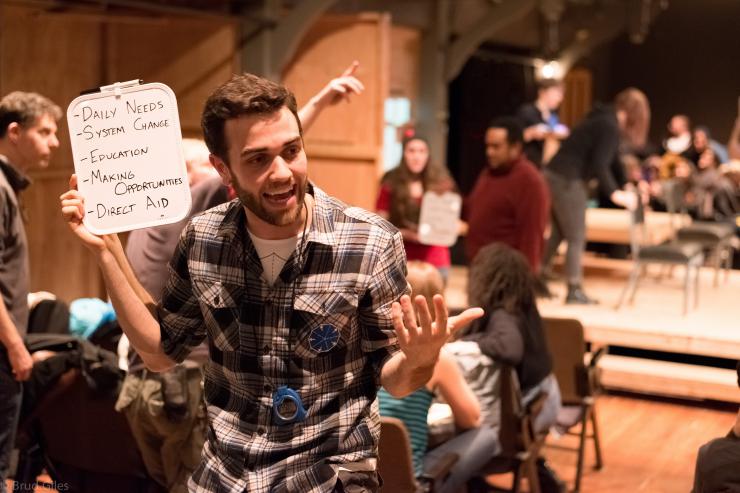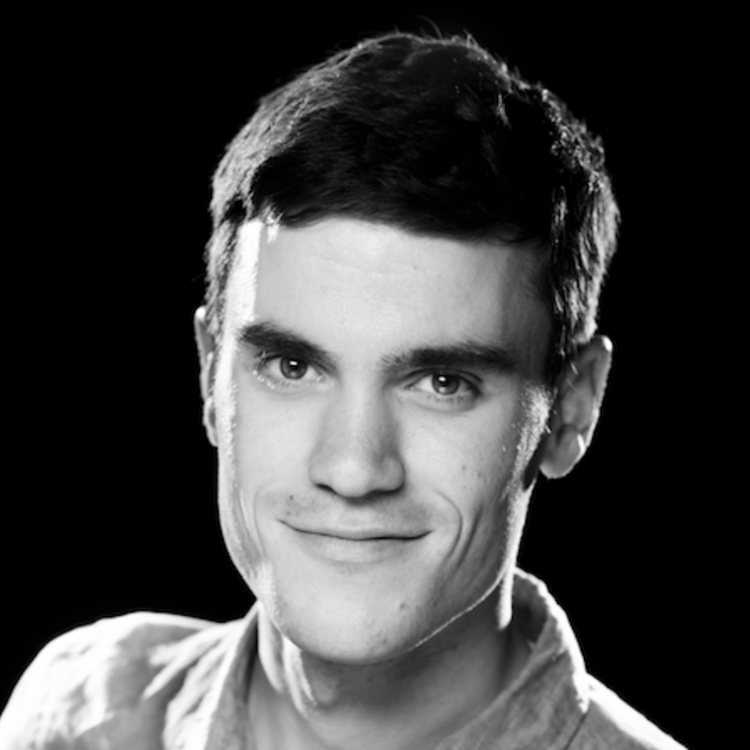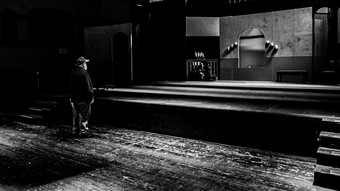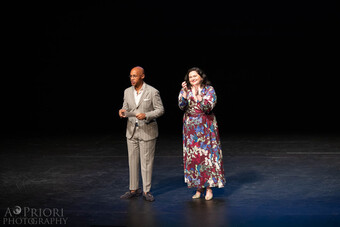Establishing the Audience Contract
Interactive forms of performance have placed audiences in a new relationship to the stories they are watching, where they are both spectator and participant. This series will explore the ways various artists and companies employ the tools of interactive theatre to complicate audiences’ individualized experiences and get them thinking about their place within a community.
Every piece of interactive theatre involves a contract with the audience. This contract implicitly and/or explicitly establishes the rules of viewership. It informs spectators how they are allowed to engage with the show’s performers, with their environment, and each other. Contracts can take myriad forms, and their various rules and theatrical devices can ultimately trigger very different thought processes for the audience.
A director’s point of view is critical to constructing a piece of interactive theatre, especially if one is looking to promote audience responsibility. What central question do I want to ask an audience? What is my goal in asking that question? When I can articulate these two answers, I can determine what rules I need to put into place for the audience, and which theatrical tools will most effectively guide them in the desired direction.
In my research of promoting social responsibility, I have been amazed at the nuances of articulating a central question. The specificity of words and even the tone of the question can greatly change an event’s contract. Take for example my old mentor, Michael Rohd of Sojourn Theatre. In his interactive performance, How to End Poverty in 90 Minutes, he asks his audience a simple, clear question: “How do you attack the problem of poverty in America, with a lens specifically focused on your community?” But simple questions often evoke vague answers. And questions that are too narrow limit the potential for true learning and growing within an event.

In talking with Rohd about the show, he explained that Sojourn asks a set of questions around the core investigation that help shape the inquiry: “If our goal is conversation and/or dialogue (two things that are not the same), what do we want to learn? What do we want to make space for? What events do we shape, and what events are we inviting audiences to co-develop within the structure of the piece?” By considering these questions, Rohd and Sojourn turned How to End Poverty into an experiment in “collective decision-making.”
The play’s contract is designed to encourage audiences to step into the unknown. There is an elaborate pre-show, which introduces spectators to the event’s participatory nature. As the play begins, the actor-facilitators inform the audience that their goal in this event is to determine how best to spend $1,000 from that performance’s ticket sales to fight poverty in their own community. Between performing theatrical vignettes that tackle various facets of poverty, these facilitators lead audience members in small group discussions about what to do with the money. They guide their groups using different prompts, advocating unvoiced points of view. They also enlist local experts on poverty to deepen the conversations. Audience members ultimately vote individually for one of five local organizations to fund.
How to End Poverty is serious in tone, but not sanctimonious. As Rohd says, the play views poverty “through the lens of compassion, curiosity and connection, not righteousness, shame, or didacticism.” When I saw the piece premiere at Northwestern University in 2013, the actor-facilitators were full of warmth, yet strongly focused. They acknowledged that poverty was a complicated topic, and therefore no perfect solution existed. Yet, they still pushed the audience to make a decision about how to spend their $1,000. Only by trying could the community learn how to better serve their impoverished citizens. The cast’s infectious energy made this task easier for every audience member.
A director’s point of view is critical to constructing a piece of interactive theatre, especially if one is looking to promote audience responsibility. What central question do I want to ask an audience? What is my goal in asking that question?
I encountered the same need for nuance while creating my thesis production at Northwestern University. Entitled Thou Proud Dream, the production was a site-specific, interactive rumination of Henry V. The production explored the ways we talk about and mythologize war, and how that rhetoric compares with veterans’ actual combat experiences. During the event, audience members followed a recent Iraq War veteran named Leroy around the outskirts of a local American Legion. Taking on the role of the Chorus character in Henry V, Leroy tried to lose himself in a fantasy of King Henry’s victory at Agincourt, focusing on Henry’s mesmerizing language. Ultimately, he was confronted and consumed by his own traumatic memories.
In creating Thou Proud Dream, I addressed complicated questions about how language interacts with trauma, healing, and memory. Through interviews with veterans, I came to believe that military rhetoric served a need for those who had been in combat. I was not interested in questioning the validity of this rhetoric, but rather in better understanding how language helped veterans heal. I wanted to explore the ethics of how military rhetoric was used to other ends. I wanted the audience to make their own decisions about how society should talk about war in the future, and still support the healing processes of veterans.
So my question ultimately became: “How is military rhetoric necessary, and how do we use such rhetoric ethically?” This question was dissonant in nature; it acknowledged rhetoric’s value while also interrogating it. When I started to develop an audience contract, I saw that dissonance needed to be a key aspect of my audience’s experience. We encouraged spectators to help Leroy conjure his fantasy of Henry V. By actively following Leroy on his quest to heal, we hoped participants might come to viscerally appreciate Henry’s language. At the same time, we attempted to establish moments where viewers could step back from this language and critically investigate it. Our contract deliberately left the audiences of Thou Proud Dream without an answer where they should stand. If I had been interested in questioning the basic value of military rhetoric, our production would have been a completely different experience, maybe full of righteousness, shame, or didacticism.
I try my best to pose a question that acknowledges the wide spectrum of experiences that spectators can and will bring to a performance. Posing this question takes a lot of investigation and reflection. But being clear with my question makes it so much easier to invite the audience into the conversation I am looking to have.












Comments
The article is just the start of the conversation—we want to know what you think about this subject, too! HowlRound is a space for knowledge-sharing, and we welcome spirited, thoughtful, and on-topic dialogue. Find our full comments policy here
This article, specifically, has me wondering if and how we can track the prolonged impact of these interactive experiences. "Ending poverty" is an interesting project but what were the long-term results of the experiment? On the first level, I'd imagine, the audience felt accomplished and impactful for having determined where $1,000 real dollars would go to addressing the issues of poverty. But then what? Did that impact their own Giving tendencies or volunteering effots 3 months down the road? 6 months? One year? Were there any follow-ups from the company regarding what positive good the money they directed did? I think the next step, and the way we continue to fight for the importance of the arts and how they can IRL impact people's lives is asking these questions over the long term, and evaluating the life-span of these projects we put our hearts and souls into.
Thank you for this series. Wonderful.
The link between audiences and funding a project is an important part of establishing theatre as a more widespread, effective community builder. This is because there needs to be more audience support, financially, for different theatre groups as public funding for the arts in america, continues to lag way behind other countries of similar world standing.
Also, artistically, engaging the audience to activate them, I believe is truly the responsibility of a piece of theatre in this time, or any time. As people move away from religious communities, there is little local communing done, and in our digital age, that is a dangerous movement away from solidarity and group preservation. It makes it much easier to be focused on individual interests when there is no interaction with a group.
Anyways, could go on and on about this, but wanted to chime in here and support this important discussion.
Thank you for your clarity on this topic and for sharing your work, Damon. I completely agree that specificity of goals and questions is key when establishing a clear and effective audience contract, especially when you want to create opportunity for both critical and visceral engagement. Can't wait to read the rest of this series!
The actor / audience contract is a time honored tradition. The storyteller/ actor has many devices to create begin this conversation from the stage: a curtain, music, lights, movement, voice, the word, costumes and spectacle to get the audience's attention....from there.....the "Aha" begins!